Selecting an interface to run your machine vision imaging system is not straightforward, but choosing the right one pays off in efficiency.
Hank Hogan, Contributing Editor
The good thing about standards, it has been said, is that there are so many to choose from. That is certainly proving to be the case for the standards used to operate the interfaces of machine vision cameras.
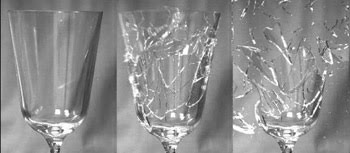
With the properly matched camera and interface, sharp imaging at several thousand frames per second becomes possible.
Robert T. Couture is a senior machine vision specialist at EngaTech Inc. in Chester, Va., whose clients are found in industries that include automotive, electronics, food and beverages, textiles and pharmaceuticals. In serving those customers, Couture noted, the company employs a number of interface standards. In fact, the list includes all that are available. “EngaTech works with GigE, Camera Link, IEEE-1394a/b [FireWire] and USB 2.0 digital formats as well as traditional analog format cameras,” he said.
He explained that interface selection depends on the speed needed, the budget available, the capabilities required, and the level of support for the interface from software and camera. A look at the various standards shows where each fits and what each does best, as well as the share of the market that each is likely to attain.
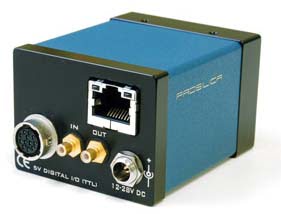
Machine vision camera manufacturers are increasingly adopting Gigabit Ethernet capability. Courtesy of Prosilica Inc.
The newest of the interfaces is GigE Vision, which is based on Gigabit Ethernet. An important complement comes from the GenICam standard, which provides an abstraction of the physical camera, turning it into a description of characteristics and properties in an extensible markup language (XML) file.
Inexpensive to execute
Gigabit Ethernet has been preferred by systems integrators when four or more cameras are involved or where long cable runs are needed. Offering a maximum distance over copper of 100 m and a maximum data rate of 1 Gb/s, GigE Vision does not require the use of a frame grabber in the host computer. That, along with the fact that it uses standard Ethernet cabling, makes GigE Vision inexpensive to implement.
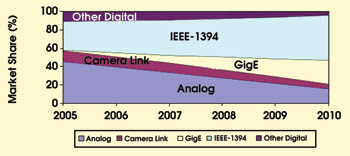
The AIA forecasts strong growth in GigE Vision camera sales. Beginning at $500,000, or 0.7 percent of the machine vision camera market, in 2005, GigE Vision sales are expected to increase to $34 million, or 26.4 percent of the market, by 2010. In addition, IEEE-1394 is expected to widen its lead over Camera Link. Courtesy of AIA.
On the downside, the interface does not provide for a way to determine that a trigger signal from the camera has been missed. Moreover, because the acquisition depends on the host’s operating system and the vagaries of network traffic, GigE Vision is not deterministic: It cannot be counted upon to acquire an image within a known and fixed time. Both of these issues, Couture said, are not critical in most cases and can be dealt with by changing the camera software.
“In general, being deterministic is not an issue unless you are dealing with extremely tight inspection time requirements,” he added.
For some users, the combination of speed, cost and distance possible with GigE Vision make it a market winner. “It may take some time just because of the momentum of the market, but there is really no reason for the bulk of the market to use anything else,” said Marty Furse, CEO of digital camera maker Prosilica Inc. of Burnaby, British Columbia, Canada.
His company has long been on the GigE Vision bandwagon and does not make any cameras that support an analog, USB 2.0 or Camera Link interface. The bulk of its business is FireWire-based cameras, however, so it is not as if the company has nothing to sell but GigE Vision-based products.
A recent projection by Paul Kellett, director of market analysis for the Ann Arbor, Mich.-based Automated Imaging Association, also forecasts significant growth in cameras with the newest interface.
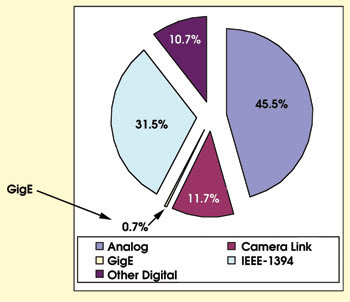
In 2005, machine vision camera sales with Camera Link and IEEE-1394 (FireWire) interfaces dominated the industry, garnering 45.5 and 31.5 percent, respectively, of the $75.6 million market. Courtesy of the Automated Imaging Association (AIA).
In 2005, Kellett reported that Gigabit Ethernet cameras totaled 0.7 percent of the market, or about $500,000 in sales out of a total North American machine vision camera market of $75.6 million. By 2010, the GigE Vision part of that market is predicted to grow to $34 million, or 26.4 percent of the market. Much of the increase will come at the expense of cameras with analog interfaces, which are typically the least expensive on the market. However, some will come from USB 2.0 and IEEE-1394b, both of which offer slower data rates and shorter cable lengths than GigE Vision.
Other interfaces, digital and not
The association’s data show that, in 2005, analog interfaces accounted for 45.5 percent of the total machine vision camera market and that FireWire was responsible for another 31.5 percent. Traditionally, analog interfaces have been used for the least expensive machine vision applications or for applications that require long cable runs; IEEE-1394a or USB 2.0 for low-end digital applications with data rates of <480 Mb/s; and Camera Link for applications where speeds in excess of 480 Mb/s are needed. The most recent incarnation of FireWire, IEEE-1394b, offers data transfer speeds of up to 800 Mb/s for cable runs of less than 4.5 m.
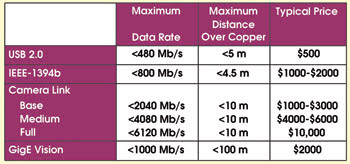
Camera users must compare both capabilities and price when selecting a suitable interface. Prices do not include imaging, network or adapter cards. Courtesy of AIA.
Like GigE Vision, but unlike either analog or Camera Link interfaces, FireWire does not require a frame grabber. Estimates put it at about the same price as GigE Vision, and the two interfaces are considerably less expensive for end users to implement than the faster Camera Link.
“Buying a GigE camera versus a Camera Link camera can drop $1000 or $2000 off their system price,” said Jay Kelbley, product manager for industrial cameras at Redlake MASD LLC of Tucson, Ariz.
Largely because of this cost differential and the easy cabling, Kelbley sees GigE Vision dominating the lower end of the market. However, analog interfaces — the oldest of all — have stubbornly clung to existence even though their demise has been predicted many times. This might continue despite the advent of GigE Vision.
Kelbley also noted that, on the high end, Camera Link offers capabilities that other interfaces do not. For one thing, it is faster than anything else. The Camera Link Full specification allows pumping out 6120 Mb/s, or more than the amount of data found on a compact disc every second. Also, Camera Link Medium and Base implementations offer rates of 4080 and 2040 Mb/s, respectively. Although the maximum cable length for Camera Link is 10 m — much shorter than for GigE Vision — it offers deterministic data acquisition. For some applications, such characteristics may be vital.
Furthermore, changes made to the specification bring it in line with current technology. For example, Kelbley cited the MiniCL connector, which was developed to allow a Camera Link connection with the smaller housings of modern cameras.
Others see the various interfaces playing different roles and serving different markets. According to Steve Cruickshank of machine vision sensor and system supplier Cognex Corp. of Natick, Mass., the company’s products support Camera Link and FireWire, and plans are to add GigE Vision support soon. He also noted that the company’s software can work with cameras and standards that are not yet supported.
Of the digital interfaces supported by Cognex’s products, Cruickshank said that there are differences that affect the application for which they are best suited. Camera Link is limited to one or two cameras per frame grabber and, although offering greater speeds at higher resolutions, is the more expensive of the two. “FireWire is a little bit cheaper, and it does very good multicamera applications,” he said.
Dwayne Crawford, a product manager at Matrox Imaging in Dorval, Quebec, Canada, said that GigE Vision suffers from latencies and timing jitter that Camera Link does not. Therefore, there are some applications where Camera Link cannot be replaced.
Changes ahead
That may not be true in the future, as standards evolve or new ones are introduced. However, Crawford noted that the software abstraction of the camera, interface and other equipment in Matrox’s and other companies’ products means that hardware changes do not have to result in software changes. That fact can lead to substantial savings in the cost of moving a project from one technology to another. “The software encompasses the largest part of the development,” he pointed out.
Unlike the other interfaces, GigE Vision has a clear upgrade path, a tenfold boost in speed possible by implementing 10 Gigabit Ethernet. The switch to the higher speed will require only changing the chips within the camera that handle the Ethernet transmission, said Eric Carey of computer vision manufacturer Dalsa Coreco in St. Laurent, Quebec. These faster chips already are available, but they are not used yet because gigabit bandwidth is deemed enough. Hence, the chips would add cost without, at the moment, adding any benefit.
Carey noted that that does not mean that those who implement GigE Vision today will be unable to take advantage of 10 GigE Vision if it becomes available. “You can keep the same tools, the same type of equipment, the same expertise, and build a 10-Gb system,” he said.
But he cautioned that raising the data rate 10 times would add to the load on the computer. With Gigabit Ethernet, that load runs a few percent on the typical machine. Increasing the data rate would raise the load to the point where the computer’s ability to deal with other processing demands might be affected.
As for the fate of the other digital interfaces, there has been a technology change that bodes well for greater data rates. Kyle Voosen, vision products manager at Austin, Texas-based National Instruments, said that the problem with high data rates has not been the interface. The ability of a PC to handle the data torrent allowed by Camera Link Full has been hampered by, among other things, the PCI bus that moves data around inside the computer at roughly 800 Mb/s.
According to Voosen, the bottleneck disappeared with the introduction of the PCI Express bus, which has a maximum of about 64 GB/s. The technology has prompted some questions. “What is coming after Camera Link to be able to acquire even more data?” he asked.
The higher data rate implies superior speed and resolution that are not vital to today’s machine vision applications but that could be important to tomorrow’s. Higher resolution and faster speed also will be of interest to those researching automobile impacts or biological systems. Such data is typically acquired for short bursts and then processed offline. With more powerful computers available in a few years, it might even be possible to handle the data online and, eventually, in real time.
Partly because of that and partly in response to such possibilities as 10 GigE Vision, faster versions of — or successors to — both FireWire and Camera Link appear to be in the works. There is no firm timetable for either, and the exact feature set of neither has been settled. However, maximum speeds of several tens of gigabits per second would be logical, given the 10-GB/s rate of 10 GigE Vision and the limits of the PCI Express bus.
Finally, it is important to keep in mind that these new standards, whether GigE Vision or the successors to the other digital interfaces, in some ways represent mixed blessings. For vision system integrators such as Graftek Imaging Inc. of Austin, Texas, new standards are both good and bad news. Robert Eastlund, vice president of sales for Graftek, said the good news is that the advent of new cameras and interfaces often provides novel capabilities that enable problems to be solved or cheaper solutions to be developed.
However, he acknowledged that replacing the old with the new is not free, carrying a cost in various ways. “Every time a new standard comes out, I basically wince, because we’ve just gotten through the bugs on the old one.”